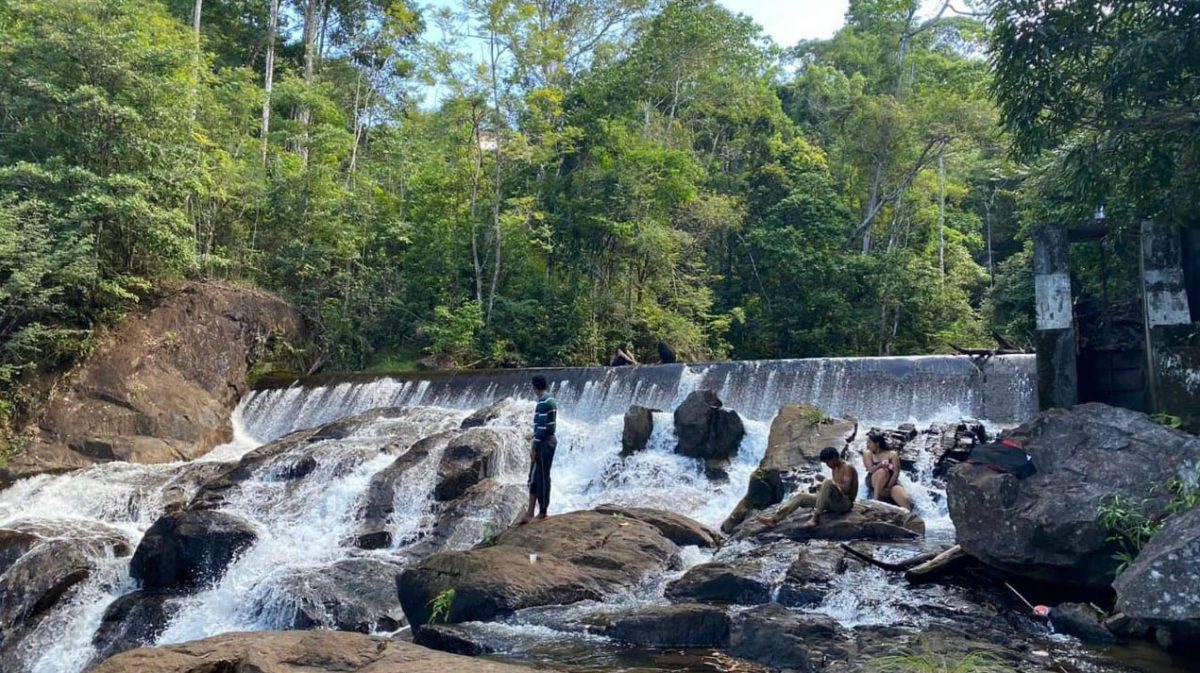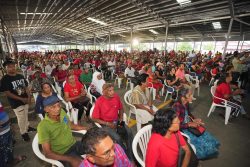There is no shortage of interesting tales derived from Amerindian folklore and from Amerindian life as a whole. One of those stories has to do with Sky Valley Waterfall and Adventure Tours, one of the myriad tourist-friendly sites situated in Guyana’s hinterland.
Sky Valley is a Region Nine village situated near the foot of the Kanuku Mountains, 15 kilometers northeast of Lethem. As with much of the hinterland and Amerindian culture, Sky Valley has its own interesting tales to tell.
One of those, as told to me by 53-year-old Alton Primus, the Manager of the Sky Valley Water Tours, has to do with a bit of the history of the place.
On a somewhat tangential note, the enterprise itself had been closed for more than a year on account of the fall-off of visitors arising from the onset of the coronavirus pandemic.
Alton, however, was far more interested in telling (almost certainly for the umpteenth time) the story of Moco Moco, or perhaps more accurately, Sky Valley, which he insists is the real name of the place. The name by which the location is these days, far more frequently called, is, Primus says, the result of the Moco Moco plant being a dominant species of vegetation in the area.
Primus, who is something of a community historian himself, says that the development of a tourism facility at the Sky Valley/Moco Moco location has its origins in a chance encounter which he had with a group of Brazilians passing his farm en route to the Sky Valley Waterfall.
In tracing the development of the falls as a tourist tourism site, Primus said that one day, upon investigating “voices” close to his farm, he discovered “four or five Brazilians” having an energetic verbal encounter with the village Toshao. The Brazilians were seeking to perpetrate what he considered to be an “invasion”… their mission being to visit the waterfall without permission from the village authorities.
It seems that whatever the outcome of the exchange, the Brazilians’ persuasiveness prevailed. They stayed, thereby becoming, apparently, the first official ‘tourists’ to visit the site. A fee of five Reals was agreed upon for the privilege. The monies collected were used to clean the compound housing the Moco-Moco hydropower station.
On July 6, 2003, a landslide disabled the power station leaving it inoperable and at the mercy of vandals who obliged, carting off the copper used in the electrical conductors and cabling. (Copper usage averages up to five times more in renewable energy systems than in traditional power generation.) It was only earlier this year, Primus said, that officials visited the site, presumably to probe the possibility of restoring the station.
The construction of the power station had commenced in May 1998 and was completed in May of the following year. One of its features is a 999-step stairway built by the Chinese engineers along the pipeline that conveys the water from top to bottom. The number 9 happens to be lucky in Chinese numerology. It represents good fortune as well as eternity. Besides, it is believed that in the Taoist tradition, these mystical 999 steps are the supreme number and the symbol of the Emperor.
Alton Primus is intimate with the territory. As a child he had hunted game there with his father. Understandably, he felt that he was a ‘good fit’ for the job of Tour Guide. The job was not without its challenges, however. In a country that is yet to create a firm tourism ‘foundation’ there used to be a time when persons were resistant to the idea of having to pay a fee to visit the falls (the aforementioned Brazilians being a good example of this). That hurdle, however, has now been crossed.
Primus said that in the course of creating a tourist attraction at the site, he sought and secured the assistance of the village Toshao and that of former Minister of Indigenous Affairs Sydney Allicock. There were also engagements with Conservation International-Guyana (CI) on matters relating to the preservation of the site.
The legitimacy of the site would now appear to be set in stone by way of a Memorandum of Understanding to which the Village Council is a signatory.
Sky Valley Waterfall Tours offers several options. There is a half-day tour that encompasses what can be an hour long ascent of the 999 stairs. The top of the stairs affords a panoramic view of the sprawling savannahs and the soothing experience of the waterfall, but be warned… getting to the top can be a physically demanding experience. As an alternative, there is the option of three days of hiking and camping in the Kanuku Mountains.
Completing the taxing ascent of the stairs proves an arduous task for many and the ascent frequently turns out to be an emotional exercise with the less able having to be urged on by the fitter members of the group.
Most of the visitors are Guyanese who reside on the coast and handfuls of Brazilians and visitors from beyond the continent. An absurdly modest fee of $1,000 is charged for entry to the facility. A percentage of the returns, which Primus says, are modest, accrue to the village, providing a subsidy of sorts for the maintenance of the two buses which, among other things, transport more than forty children to school at St Ignatius.
With approximately twenty visitors experiencing the site every month, what is evidently missing is the kind of state input that will grow the site into a profitable tourism facility.
Early in 2020 Primus made an investment of $350,000 in the construction of a benab for visitors to the site. He expects to recover his investment over a period of time.
For now, however, the facility is closed on account of the Covid-19 pandemic.
A point has been reached, Primus says, where small interior-based tourism operations like Sky Valley need interventions from the Guyana Tourism Authority. “They need to see, first hand, the challenges that we face,” Primus says. “The government can also assist with the marketing of these sites,” he adds. “Marketing costs are prohibitive for small operators. We also need training for tour guides.”
Primus is also advocating the creation of a skills-training facility for young people in hinterland communities. “We are desperately needing to reduce the level of migration by our youngsters, fresh out of school, to Brazil or to Georgetown where their potential is lost to their communities.”
Moco Moco has a population of roughly five hundred persons. These are divided into approximately sixty-five households. Their livelihoods depend largely on farming… bitter and sweet cassava, vegetables, plantains and bananas. Smaller numbers are involved in cattle rearing.
Primus himself plants bananas and plantains. Along with the other villagers he takes his yield to market at Lethem, including some supermarkets. There is, he says, a demand for bananas. Apparently, residents of Roraima in the more densely-populated Brazil, favour bananas.
If these options remain key to his livelihood, he believes that the natural attractions with which his part of the world is endowed, are more than deserving of his personal interest and the interest of those others whose task it is to transform the community and its natural attractions into an enhanced way of life for the people who reside there.










